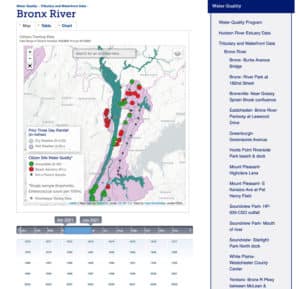Overview
Project Water DROP (Detecting River Outfalls and Pollutants) addresses outpouring of Enterococcus into the Bronx River. One of the “Big Three” major water quality issues on the river, Enterococcus is a genus of bacteria that is often found in animal waste and can cause illness for those who come into contact with contaminated water. Importantly for us, it indicates the presence of raw sewage. Citizen scientists participate by collecting water samples (wearing protective gloves for safety) at 15 locations along the entire length of the Bronx River. These water samples are then processed to get the count of Enterococcus cells, and this provides us with a snapshot of the health of the Bronx River from top to bottom. Beginning in May, stewards are trained and volunteer to sample at locations of their choice and then go off on their own to collect water samples. The project allows stewards to help investigate violations of the Clean Water Act, and help us put pressure on our elected officials to improve our municipal infrastructure to protect the environment!
Click here to learn more about Project Water DROP and the Bronx River’s sewage situation. To view the most current data for the Bronx River and other water bodies within the watershed, check out RiverKeeper’s amazing interactive map!
Documents
Photo Gallery
Highlights
2019 Project Water DROP Results
The spring and summer months in 2019 were soaked by well-above-average rainfall that caused frequent flooding events in the New York Metropolitan area. This excess water is reflected very clearly in the water quality data from 2019. The graphs below show, for the years 2017-2019, the average amount of acceptable versus unacceptable conditions at each monitoring site along the length of the Bronx River as well as the number of samples that exceeded the maximum number of bacterial that can be counted (24,196 cells.)
Special thanks to Korin Tangtrakul and Westchester Community Foundation for making this data visualization possible.
The average Enterococcus bacteria counts throughout the 2019 monitoring season were much higher than average – almost twice as high as usual in some places. A total of 14 samples had bacterial counts that were so high they could not be properly counted (more than 24,196 cells per 100 mL or water.) The only sampling site that didn’t see above average bacterial counts was at Burke Bridge in the Bronx River Forest. We are seeing that this pollution has steadily gotten worse over the years, with fewer samples being acceptable. While Combined Sewage Outfalls (CSOs) are found throughout the South Bronx, water samples from the lower river have less bacteria on average than samples from the upper river. Despite there being no CSOs along the Bronx River above 180th Street, we continue to see dangerously high levels of fecal indicator bacteria in Westchester and the upper river, especially near Mount Pleasant and White Plains. Since this pollution cannot be explained by CSO activity, the sources must be from illegal wastewater hook-ups and discharges to the river, as well as leaks in sewage infrastructure. Focusing our monitoring efforts in Westchester will aid in our understanding of the sources of this contamination as well as what we can do to stop it.
Get Involved
Interested in participating in our water quality research program? Email Ecology@bronxriver.org to learn more!
Contact
You can also send us a message through the same email at Ecology@bronxriver.org.








